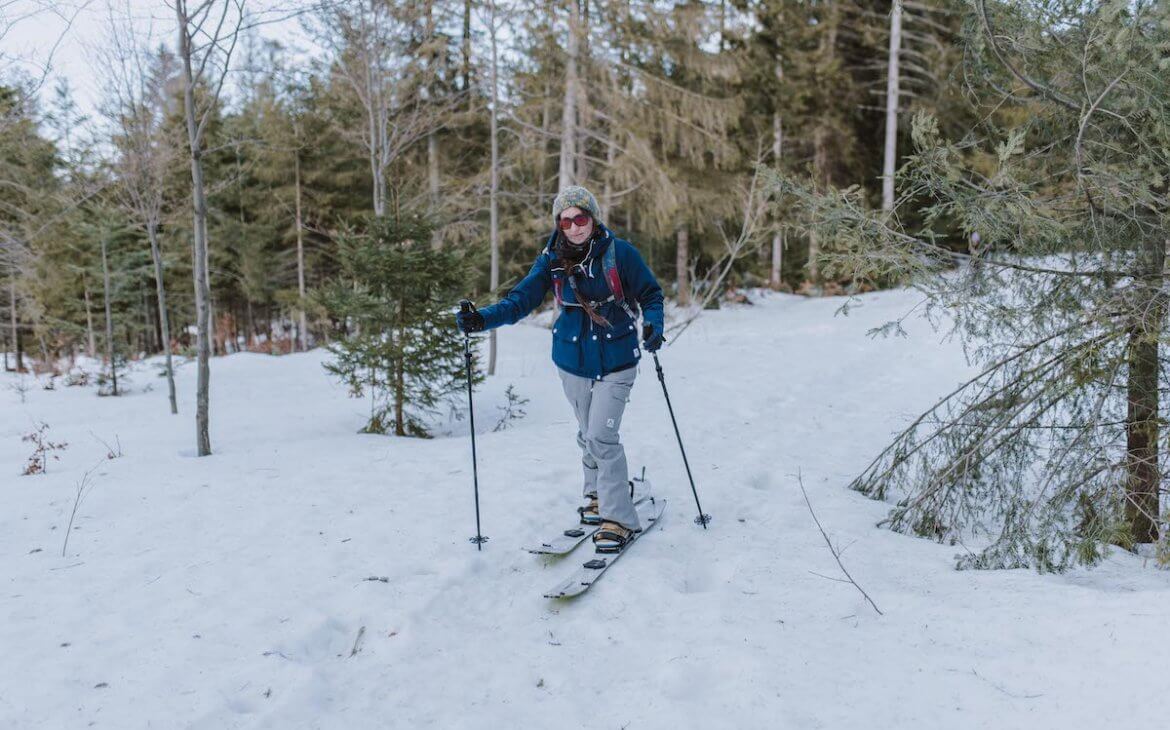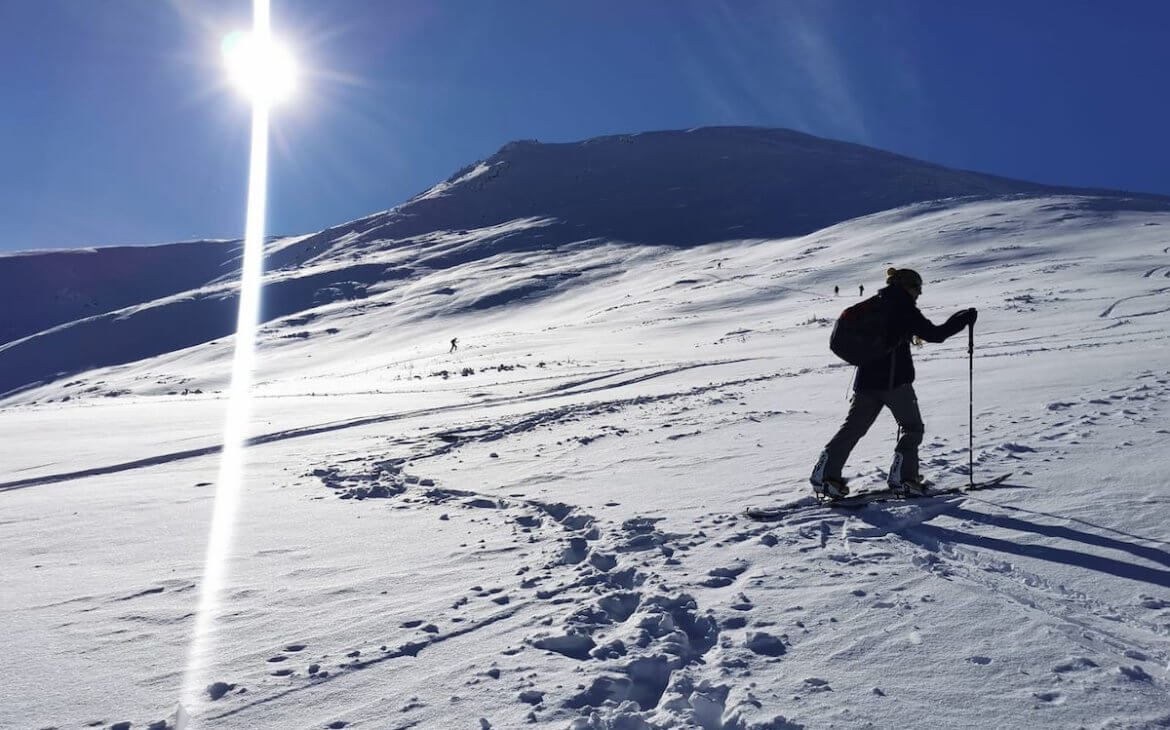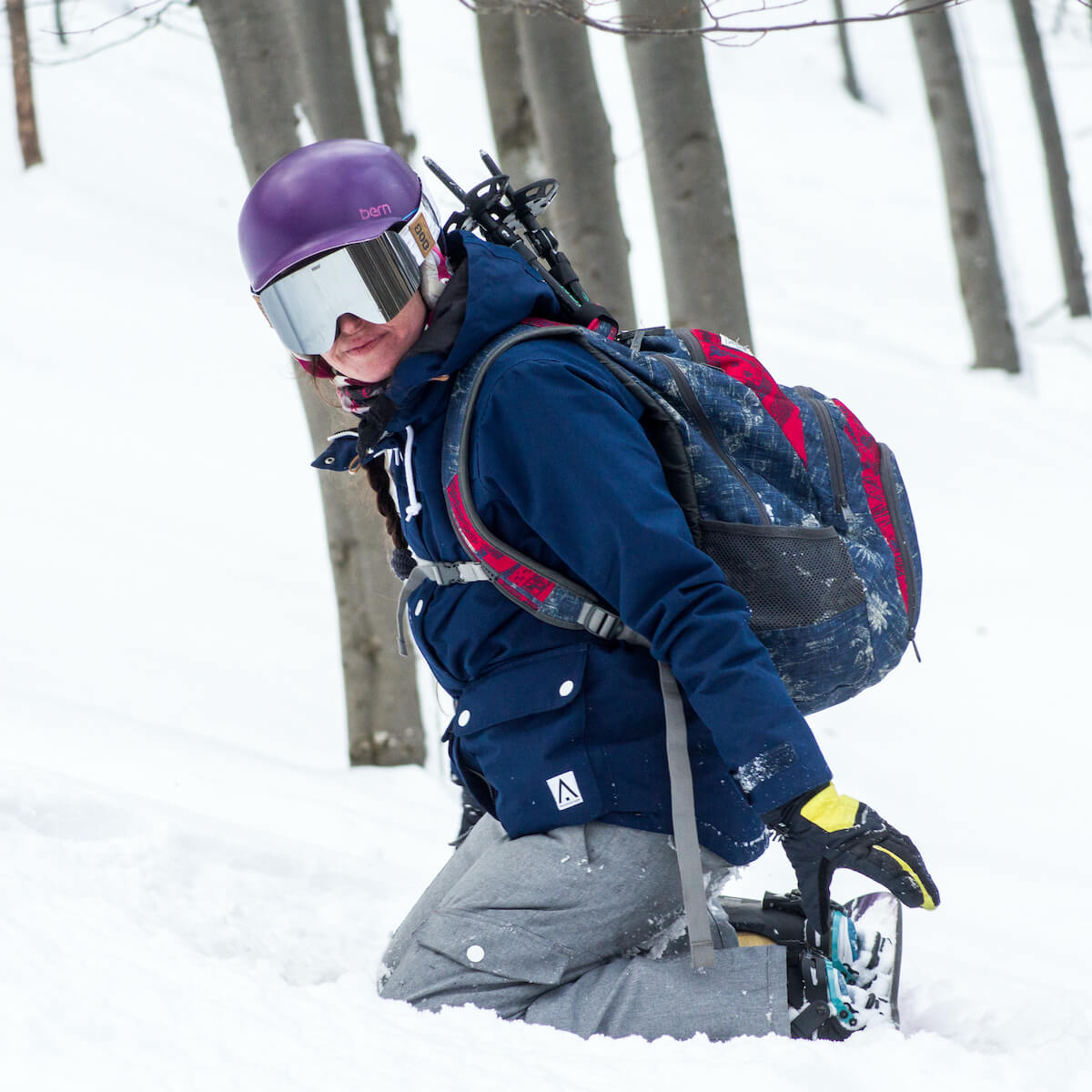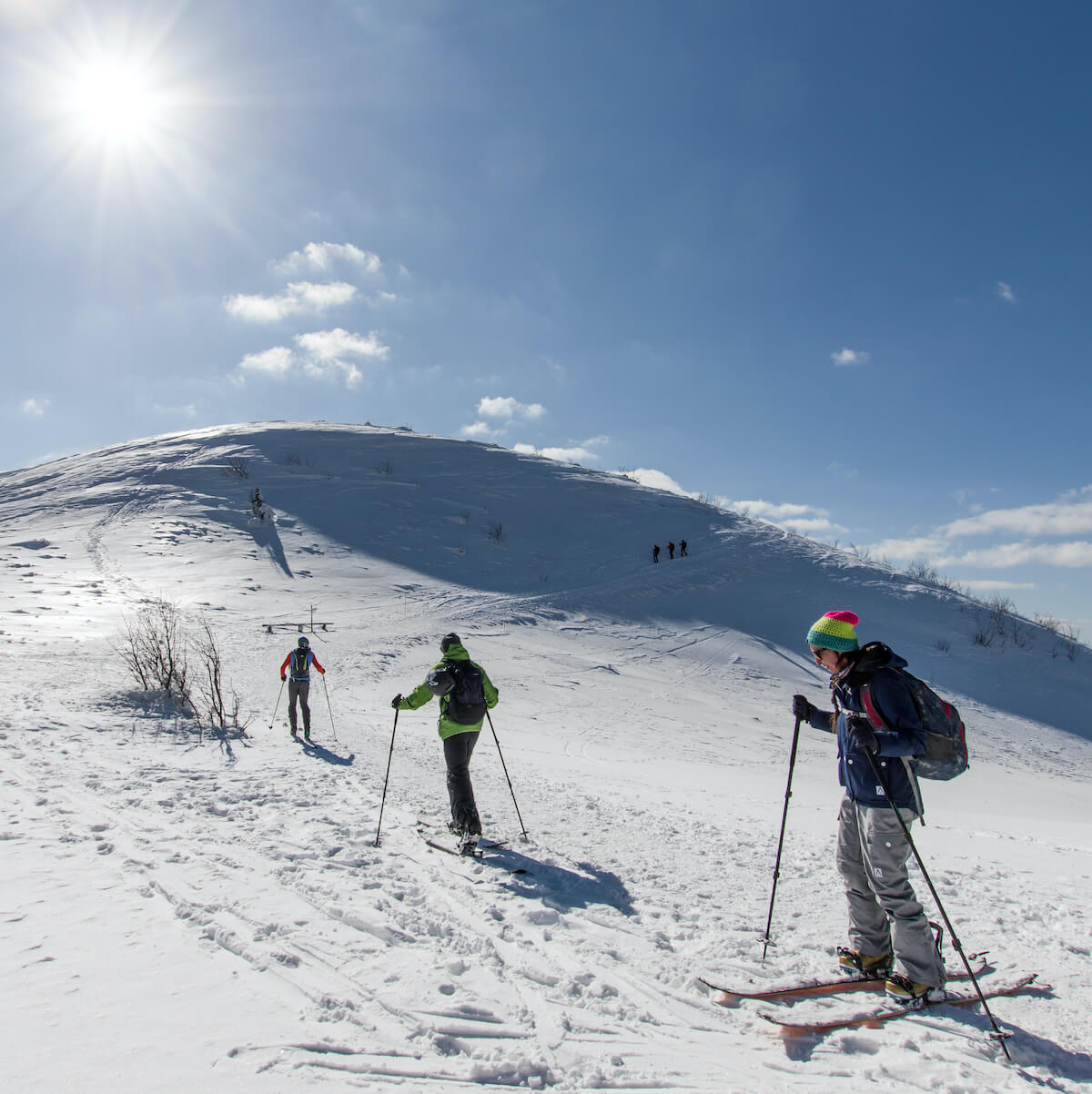Imagine hiking to the top of a mountain, surrounded by pristine scenery and untouched snow. Then strapping into your board and carving down the mountain, experiencing the rush of fresh powder. Welcome to the world of splitboarding – the ultimate combination of adventure, adrenaline, and pure joy!
Splitboarding is the perfect choice for experienced snowboarders looking for a new level of excitement and challenge. It is also an exciting way to explore the backcountry and escape the crowded resorts.
This article will guide you through the essentials of splitboarding, from gear to safety to destinations. So, whether you’re ready to take the leap into the world of splitboarding or just want to learn more about this thrilling sport, keep reading!

What is Splitboarding
Splitboarding is the ultimate mashup of snowboarding and backcountry touring. It’s like taking a snowboard and slicing it down the middle, transforming it into two ski-like planks that allow you to climb the mountain with ease. Then, when you reach the top, simply snap the planks back together and enjoy the ride down. Unlike traditional snowboarding, splitboarding lets you explore uncharted territories and conquer the wildest peaks. And unlike ski touring, you don’t have to trade in your snowboard for skis! This way, you can keep your board and still experience the thrill of ascending the mountain.
Splitboarding is a perfect way to combine your love for snowboarding with a thrilling backcountry adventure.

Splitboard Setup: The Gear You Need to Succeed
Here’s a list of essentials that you’ll want to bring along for the ride:
The splitboarding must-haves:
- Splitboard
- Bindings compatible with splitboard
- Snowboarding boots
- Skins for ascending the mountain
- Poles for balance and to give legs a break
- Backpack for carrying essentials
- Helmet for the ride down
- Safety gear: beacon, shovel, and probe
- Goggles and/or sunglasses (I prefer to wear sunglasses on the way up and switch to goggles for the descent. This way, I’m protected from the sun and wind on the way up and can see clearly when I pick up speed on the way down.)
- Water
- Snacks (also something sweet to boost your energy)
The nice-to-haves:
- Crampons for steep or icy sections
- Headlamp in case it gets dark before you go down (winter days are pretty short)
- Vacuum flask with hot tea
What to wear for splitboarding
When it comes to clothing, layering is key. You’ll need to be prepared to peel off a layer or two as you hike up the mountain, but once you reach the top, the temperature can drop quickly. It’s essential to wear a waterproof snowboarding jacket and pants to protect against the elements. For added comfort and warmth, consider layering with moisture-wicking base layers and an insulating mid-layer. When it comes to gloves, it’s best to bring two pairs – a lighter pair for the ascent and a warmer pair for the descent. Don’t forget a beanie for the hike up and a helmet for the descent for added protection.

Popular Splitboarding Destinations
The most popular splitboarding destinations are the ones known for their incredible freeride opportunities. Places like Verbier, home to the Xtreme Verbier freeride competition, Chamonix, the Lofoten Islands, Rocky Mountains, Whistler, Alaska, Iceland, Hokkaido in Japan, Georgia, Kyrgyzstan, and Patagonia are just a few examples. With so many options, splitboarders can choose from totally wild and remote locations or ski resorts known for their outstanding freeride conditions. Beginners should start at a ski resort, where you can learn the basics of splitboarding and safety before venturing into the backcountry. Some resorts, like Verbier, even have freeriding trails marked on maps, making it easier for new riders to get started. If you’re new to splitboarding, joining a guided tour is recommended. This will give you a chance to learn the basics, including how to assemble your gear and what to do in case of an avalanche. By starting in a ski resort and taking a guided tour, you can gain the skills and experience you need to enjoy this thrilling sport safely.

What makes Splitboarding so Awesome
Splitboarding offers a unique combination of physical challenge, breathtaking scenery, and pure excitement. Whether you’re looking for adventure or seeking fresh powder, splitboarding is a perfect choice. Here are just a few of the reasons why this sport is so much fun:
- The thrill of the ascent: Hiking to the top of the mountain is a workout in itself, but it’s also a chance to connect with nature and soak in the stunning scenery.
- Fresh powder: The descent is what splitboarding is all about, carving down the mountain through untouched snow and experiencing the rush of fresh powder.
- Adventure: Exploring new terrain in the backcountry offers a unique and exciting adventure that can’t be found at a resort.
- Sense of accomplishment: Completing a backcountry descent takes skill, endurance, and determination, making every run a satisfying accomplishment.
- Adrenaline rush: Splitboarding is an adrenaline-fueled sport that will keep you on the edge of your seat as you navigate challenging terrain and experience the thrill of carving down the mountain.

Adventure Responsibly: Stay Safe while Splitboarding
Splitboarding is a thrilling and adventurous sport, but it also comes with inherent risks and challenges. That’s why it’s important to prioritize safety and always adventure responsibly. Here are the most important rules you should follow to stay safe in the backcountry:
- Never splitboard alone; always bring a partner or group of friends with you. Make sure someone knows your route and expected return time.
- Familiarize yourself with backcountry hazards, such as avalanches and extreme weather conditions.
- Know the conditions before you start your ascent. Look for signs of avalanches or other hazards and adjust your route if necessary.
- Check the weather before you start your trip and be prepared for any changes. Avoid riding in extreme weather conditions.
- Always bring and know how to use the proper safety equipment, such as a beacon, shovel, and probe.
- Know your limits and only ride within your skill level. Take a course or guided tour if you’re new to splitboarding.
- Wear proper gear, such as a helmet, headlamp when dark, and warm clothing, to keep you safe and comfortable.
- Bring enough water and food: Hydration and nourishment are important for endurance and safety.
Last but not least: Respect the environment by avoiding making new trails and sticking to designated areas. Leave no trace and help protect the backcountry.

Exploring the Backcountry in 10 Steps: what a Splitboard Trip looks like
- Disassemble your splitboard: Release the clips and separate the two halves of the board.
- Attach the skins to the bottom of your splitboard skis. Make sure they are attached securely and facing the right direction.
- Adjust your bindings to the right position.
- Adjust the length of your poles to match your height.
- Make sure you have all the essentials in your backpack, including food, water, extra layers, and safety gear (beacon, shovel, probe, etc.).
- Begin your ascent: Start your ascent by walking with your splitboard on your feet, using your poles for balance. Make sure you’re following a safe and well-planned route.
- Reach the top: When you reach the top of the mountain, take a moment to rest, hydrate, and eat.
- Convert your splitboard: To ride down, you’ll need to convert your splitboard back into a snowboard. It is done by connecting the two halves of the board and reattaching the bindings to the board.
- Check your gear: Before starting your descent, make sure your bindings are securely attached, and all your gear is in place.
- Enjoy the ride: Now you’re ready to enjoy the ride down! Take in the scenery, make turns, and have fun.

Splitboarding FAQ
What is splitboarding?
- Splitboarding combines snowboarding and backcountry touring, allowing you to ascend the mountain on splitboard skis and then ride down on a snowboard.
How is splitboarding different from snowboarding and ski touring?
- Splitboarding is different from traditional snowboarding because it allows you to explore the backcountry on your snowboard. It is different from ski touring because you don’t have to trade in your snowboard for skis.
What equipment do I need for splitboarding?
- The most essential piece of equipment for splitboarding is a splitboard. You’ll also need bindings compatible with your splitboard, skins for ascending the mountain, a backpack for carrying essentials, poles for balance, and crampons for steep or icy sections.
Can I use my regular snowboard for splitboarding?
- No, you’ll need a specific splitboard designed for backcountry touring.
What are skins and crampons and why do I need them for splitboarding?
- Skins are strips of material that attach to the bottom of your splitboard skis and provide traction for ascending the mountain. Crampons are attachments for the splitboard bindings and are used to increase traction and stability when climbing steep or icy terrain.
Do I need to have a lot of experience snowboarding to start splitboarding?
- It’s best to have a solid foundation of snowboarding skills before starting splitboarding (also riding off-piste). It’s also important to take a splitboarding course or guided tour to learn proper techniques and safety practices.
Is splitboarding safe?
- Splitboarding can be safe if you have the proper training and equipment, and follow safe backcountry practices such as carrying a beacon, shovel, and probe. However, as with any backcountry activity, there are inherent risks involved.
What are the best destinations for splitboarding?
- Popular splitboarding destinations include the backcountry of the Rocky Mountains, the European Alps, and Japan.
How do I get started with splitboarding?
- You can get started with splitboarding by taking a splitboarding course or guided tour.
Splitboarding is a unique and exciting way to combine your love for snowboarding and backcountry touring. From exploring new terrain in the backcountry to carving through fresh powder, it is a sport that promises a sense of accomplishment and an unforgettable adventure. I hope that after reading this article, you’re inspired to give splitboarding a try and experience the thrill of exploring the backcountry in a whole new way!

